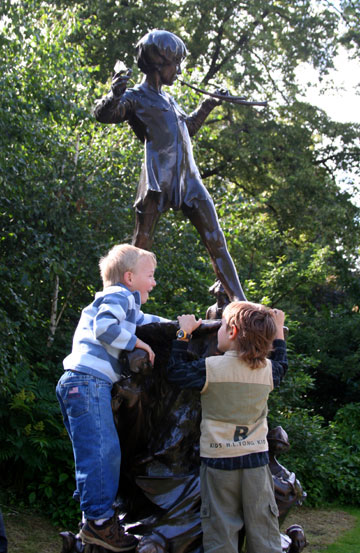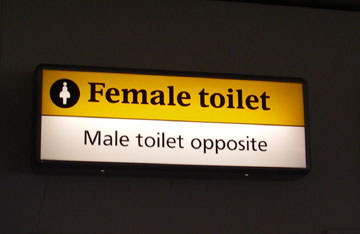Part 8 of series: European Reflections 2006
Permalink for this post / Permalink for this series
In my last post I talked a bit about Peter Pan, who was “created” in Kensington Gardens, Londan, through the creativity of J. M. Barie. Today I thought I’d share a few more fun pictures from this lovely park.
 There are lots of signs throughout Kensington Gardens, which is especially helpful for tourists. But my favorite part of the signs was the detail attached to those indicating where the toilets were. We’d say “restrooms,” of course. If you look closely at the picture to the right, you’ll see that the sign specifies the precise distance to a given toilet. In one direction you’ve got a walk of 300 meters. It’s 400 in the other direction. How helpful! Especially if, as you’re looking at the sign, you’re feeling particularly desperate to find the nearest toilet. Those British are so thoughtful.
There are lots of signs throughout Kensington Gardens, which is especially helpful for tourists. But my favorite part of the signs was the detail attached to those indicating where the toilets were. We’d say “restrooms,” of course. If you look closely at the picture to the right, you’ll see that the sign specifies the precise distance to a given toilet. In one direction you’ve got a walk of 300 meters. It’s 400 in the other direction. How helpful! Especially if, as you’re looking at the sign, you’re feeling particularly desperate to find the nearest toilet. Those British are so thoughtful. As my wife and I walked around London, I saw a greater variety of people than I have seen anyplace else, I think. There were beautiful people, immaculately dressed, and homeless folk in virtual rags. There were lots of young, atheletic folk jogging through the parks and along the Thames, and there were dowdy, older folk who looked as if they were the poster children for the stereotypical British middle class. No doubt they boiled their vegetables and had tea every afternoon. There were many people walking alone in Kensington Park, enjoying the sylvan beauty and the quiet. And there were also many couples strolling along romantically, or, as you can see in the photo to the right, snogging in public, seemingly oblivious to all who were walking by. (“Snogging” is a British word made popular by J.K. Rowling. From the picture you can guess the meaning.)
As my wife and I walked around London, I saw a greater variety of people than I have seen anyplace else, I think. There were beautiful people, immaculately dressed, and homeless folk in virtual rags. There were lots of young, atheletic folk jogging through the parks and along the Thames, and there were dowdy, older folk who looked as if they were the poster children for the stereotypical British middle class. No doubt they boiled their vegetables and had tea every afternoon. There were many people walking alone in Kensington Park, enjoying the sylvan beauty and the quiet. And there were also many couples strolling along romantically, or, as you can see in the photo to the right, snogging in public, seemingly oblivious to all who were walking by. (“Snogging” is a British word made popular by J.K. Rowling. From the picture you can guess the meaning.) I was especially impressed by the ethnic diversity throughout London, including Kensington Gardens. I wonder if London is the most international, multi-cultural city on Earth. Though I saw plenty of Anglos, I was amazed by the number of Indians, Africans, Middle-Easterners, and Asians. Among the Muslim women, some wore simple scarves, while others were dressed in complete burkas, with only their eyes showing. In the photo to the right, the woman is not wearing a full burka, since her face is visible. In days gone by, the world was ruled out of London. Today, the world has come to Longdon.
I was especially impressed by the ethnic diversity throughout London, including Kensington Gardens. I wonder if London is the most international, multi-cultural city on Earth. Though I saw plenty of Anglos, I was amazed by the number of Indians, Africans, Middle-Easterners, and Asians. Among the Muslim women, some wore simple scarves, while others were dressed in complete burkas, with only their eyes showing. In the photo to the right, the woman is not wearing a full burka, since her face is visible. In days gone by, the world was ruled out of London. Today, the world has come to Longdon.

